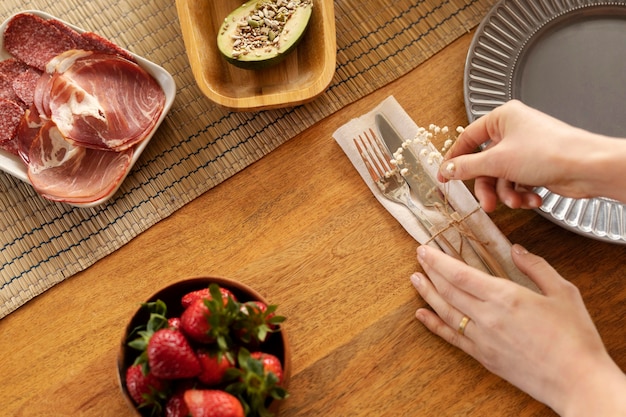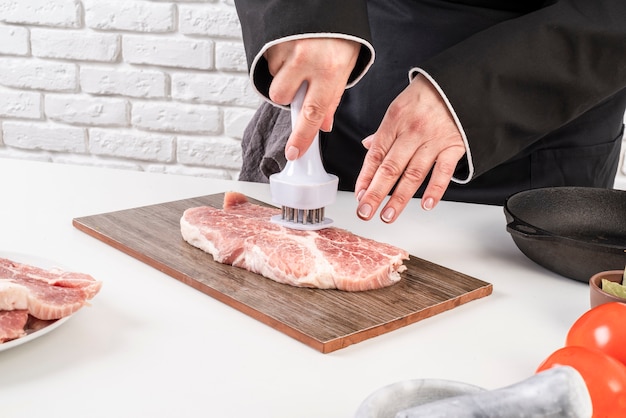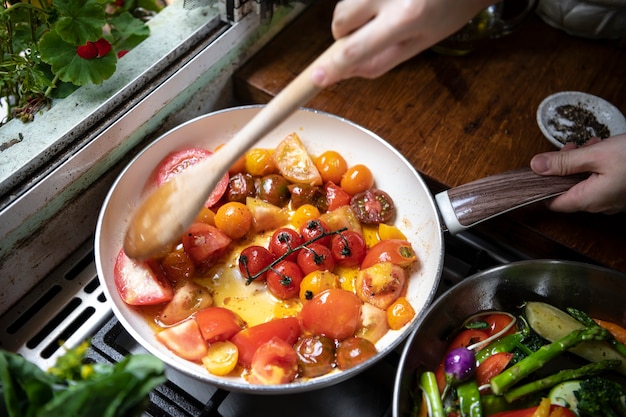Let's be honest, pork can be a bit of a culinary enigma. We all love a succulent roast, a crispy crackling, or a juicy pork chop, but that lingering worry about food poisoning can be a real buzzkill. No one wants to spend their evening feeling under the weather after a delicious meal, right? So, I’m here to share my hard-earned wisdom and personal experiences about cooking pork safely and deliciously. Over the years, I’ve learned a few tricks of the trade, and I'm excited to pass them on to you. This guide will cover everything from the absolute basics to handy tips and tricks, and I’ll even address those nagging questions that pop up when it comes to pork. Let's get cooking!
Part 1: Pork: The Basics

First things first, let's address the elephant in the room: pork, like any meat, needs to be cooked thoroughly to eliminate any harmful bacteria. But what does "thoroughly" actually mean? It means ensuring the meat reaches a safe internal temperature, all the way through. This is where a trusty meat thermometer comes in. Trust me, it's an absolute game-changer! It's a real shame to rely solely on visual cues because the colour of the meat can be incredibly deceptive.
1.1 The Importance of safe cooking temperatures
The UK Food Standards Agency recommends a minimum internal temperature of 71°C (160°F) for pork. This temperature guarantees the elimination of any harmful bacteria, making the meat safe for consumption. When using a digital thermometer, it's best to insert it into the thickest part of the meat, ensuring it avoids any bones. For larger roasts, it might be necessary to check the temperature in multiple spots to guarantee even cooking.
1.2 What Happens if You Don't Cook Pork Thoroughly?
Now, I'm not trying to scare you, but it's essential to understand the potential risks of undercooked pork. You might end up with food poisoning caused by bacteria like Salmonella and Campylobacter. Symptoms can range from mild discomfort like nausea and diarrhoea to more serious complications. It's simply not worth the risk.
Part 2: Cooking Pork Safely

Now that we've tackled the basics, let's delve into some practical tips for ensuring your pork is cooked safely and perfectly.
2.1 The Role of Time and Temperature
Remember, cooking time is just as crucial as reaching that magical 71°C (160°F). It's not just about hitting the target temperature; you need to make sure the pork is cooked long enough to eliminate those pesky bacteria. Here's the thing: the thicker the cut of meat, the longer it will take to cook through. So, always adjust your cooking time accordingly.
2.2 Cooking Pork in the Oven
Oven cooking is a classic way to prepare pork, perfect for roasts, chops, and even whole joints. Here are some tips for achieving oven-cooked pork perfection:
- Preheat your oven to the temperature specified in your recipe. This ensures the meat cooks evenly and prevents it from getting tough.
- Use a roasting tin that's large enough to accommodate the pork without overcrowding. This allows for even heat circulation and ensures the meat cooks evenly.
- Make sure your thermometer is inserted into the thickest part of the meat, away from any bones. This is where the meat takes the longest to cook, so you want to ensure it reaches the correct temperature.
- Allow the pork to rest for 10-15 minutes after cooking. This allows the juices to redistribute, resulting in a more tender and juicy piece of meat. Resting is crucial for maximizing the flavor and tenderness.
2.3 Cooking Pork on the Stovetop
For smaller cuts of pork, like chops and steaks, stovetop cooking is a fantastic option. Here's how to do it safely and expertly:
- Use a heavy-bottomed skillet or pan. This helps to distribute heat evenly, preventing hot spots and ensuring consistent cooking.
- Heat the oil or butter over medium heat. The pan should be hot enough to sear the pork, creating a lovely crust, but not so hot that it burns.
- Cook the pork for 2-3 minutes per side, or until it's browned and cooked through. This searing process helps to lock in the juices and flavors.
- Use a meat thermometer to check the internal temperature. This is the ultimate way to ensure your pork is cooked through to a safe temperature.
2.4 Cooking Pork on the BBQ
Barbecuing is another fantastic way to cook pork, adding a smoky depth of flavour and perfect for outdoor entertaining. Here's what you need to know to achieve BBQ pork perfection:
- Preheat your barbecue to medium heat. A hot barbecue will ensure the meat cooks quickly and avoids drying out.
- Season the pork with your favourite rub or marinade. Experiment with different flavor combinations to elevate your BBQ experience.
- Cook the pork over indirect heat, away from the direct flames. This prevents the meat from burning and allows it to cook slowly and evenly.
- Keep the lid closed for most of the cooking time to trap in the heat and moisture. This creates a convection oven effect, ensuring the meat cooks through and stays juicy.
- Use a meat thermometer to check the internal temperature. This is essential for ensuring the pork is cooked through to a safe temperature.
Part 3: Understanding Different Cuts of Pork

Let's talk about those different cuts of pork. Each cut has its own unique texture and flavor, making it suitable for various cooking methods. Knowing what you're working with makes a world of difference in how you cook it.
3.1 pork loin
This cut is a versatile favourite and can be roasted, grilled, or pan-fried. It's lean, tender, and perfect for a juicy roast or succulent chops. It's a great choice for those who prefer a leaner cut of meat.
3.2 pork shoulder
This cut is known for its rich flavor and fat content, perfect for slow cooking methods like braising or roasting. It's ideal for pulled pork, stews, and hearty dishes. This is a great option if you're looking for a cut with more flavor and a richer texture.
3.3 pork belly
Ah, the pork belly! This fatty, delicious cut is perfect for crispy crackling or slow roasting. It can be a bit challenging to cook, but the results are worth the effort. This cut is definitely for those who appreciate a rich, fatty pork experience.
3.4 pork chops
These are versatile and can be grilled, pan-fried, or baked. They are leaner than pork loin and cook quickly, making them a perfect choice for a quick weeknight meal.
3.5 pork ribs
Oh, ribs! A classic barbecue favourite. These are slow-cooked for maximum tenderness and flavour, perfect for a backyard cookout. Ribs are a real crowd-pleaser and a great choice for special occasions.
Part 4: pork recipes: Some of My Favourites
I've been cooking pork for years, and I've developed a few favourite recipes that I'd love to share with you. They're all tried and tested, and I guarantee they'll impress your family and friends.
4.1 Classic roast pork
This is a classic dish that's perfect for a special occasion. Here's what you'll need:
- 1.5-2kg pork loin or shoulder
- Salt and pepper
- Rosemary, thyme, or other herbs (optional)
- 1 tablespoon of olive oil
Instructions:
- Preheat your oven to 180°C (350°F). This ensures the meat cooks evenly and prevents it from getting tough.
- Season the pork generously with salt, pepper, and your chosen herbs. This will add a burst of flavor to your roast.
- Rub the pork with olive oil. This will help create a crispy skin and prevent the meat from drying out.
- Place the pork in a roasting tin and cook for 1 hour and 30 minutes, or until the internal temperature reaches 71°C (160°F). This will ensure the meat is cooked through and safe to eat.
- Let the pork rest for 10-15 minutes before carving and serving. This allows the juices to redistribute, resulting in a more tender and juicy piece of meat. Resting is crucial for maximizing the flavor and tenderness.
4.2 Honey Garlic Pork Chops
These are a delicious and easy weeknight meal. Here's what you'll need:
- 4 pork chops
- 2 tablespoons of honey
- 1 tablespoon of soy sauce
- 1 clove of garlic, minced
- 1 tablespoon of olive oil
Instructions:
- In a small bowl, whisk together honey, soy sauce, garlic, and olive oil. This creates a delicious and flavorful marinade.
- Place the pork chops in a shallow dish and pour the honey garlic mixture over them. Ensure the chops are fully coated in the marinade.
- Marinate the pork chops for at least 30 minutes, or up to 2 hours. The longer the marinade sits, the more flavorful the chops will be.
- Heat a heavy-bottomed skillet over medium heat. This will help distribute the heat evenly and prevent the chops from sticking.
- Add the pork chops to the skillet and cook for 3-4 minutes per side, or until cooked through. This ensures the chops are cooked to a safe temperature and develop a nice crust.
4.3 slow cooker pulled pork
This is a crowd-pleaser that's perfect for a party or family gathering. Here's what you'll need:
- 1.5-2kg pork shoulder
- 1 onion, chopped
- 2 cloves of garlic, minced
- 1 cup of barbecue sauce
- 1 cup of chicken stock
Instructions:
- Place the pork shoulder in your slow cooker. This will ensure the meat cooks slowly and evenly, resulting in incredibly tender pulled pork.
- Add the onion, garlic, barbecue sauce, and chicken stock. This will create a flavorful base for your pulled pork.
- Cook on low heat for 8-10 hours, or on high heat for 4-5 hours, or until the pork is tender and pulls apart easily. This slow cooking process will render the fat and create an incredibly tender and juicy pulled pork.
- Shred the pork using two forks. This will break down the meat into easy-to-eat strands.
- Serve on buns with your favourite toppings, such as coleslaw, pickles, and onions. This creates a delicious and satisfying pulled pork sandwich.
Part 5: Pork and Health
Now, let's talk about pork and health. It's often a subject of debate, but I'm here to clear up some common misconceptions.
5.1 The 'Fat' Factor
Pork can be a bit fatty, that's true. But it's not all bad! Pork fat is actually rich in flavour and can be quite healthy in moderation. It contains unsaturated fatty acids, which are good for your heart. Plus, a little bit of fat helps to keep pork tender and juicy. The key is to choose leaner cuts of pork and trim off any excess fat before cooking. This helps to create a healthier and more flavorful meal.
5.2 Pork and Cholesterol
We've all heard about cholesterol, haven't we? Pork does contain some cholesterol, but it's not as high as some people think. Plus, the cholesterol in pork is primarily found in the fat, so trimming off the fat can help to reduce your intake. It's all about moderation, folks! A balanced diet and regular exercise are key to maintaining healthy cholesterol levels.
5.3 Pork and Vitamins and Minerals
Pork is a good source of essential vitamins and minerals, including:
- Thiamine (B1)
- Riboflavin (B2)
- Niacin (B3)
- Vitamin B6
- Vitamin B12
- Iron
- Zinc
- Potassium
So, pork can be a nutritious part of a healthy diet when enjoyed in moderation.
Part 6: Tips for Selecting and Storing Pork
To ensure your pork is safe and delicious, it's important to choose it carefully and store it correctly. A little extra care goes a long way.
6.1 Selecting Pork
When you're at the supermarket, look for pork that's:
- Firm and springy to the touch. This indicates that the meat is fresh and hasn't been sitting around for too long.
- Has a light, even pink colour. This is a sign of fresh, high-quality pork.
- Is free of any discolouration or unpleasant odours. This is a good indicator that the meat is fresh and hasn't gone bad.
- Is packaged securely and labelled with a use-by date. This ensures that the meat is fresh and hasn't been stored improperly.
6.2 Storing Pork
Once you've got your pork home, it's crucial to store it correctly:
- Refrigerate pork immediately, at a temperature of 5°C (41°F) or below. This helps prevent the growth of bacteria and keeps the meat fresh.
- Store pork on a lower shelf in the refrigerator, to prevent any juices from dripping onto other food. This helps to prevent cross-contamination.
- Never store pork next to raw poultry or fish. This helps prevent the spread of bacteria from one type of meat to another.
- Use pork within 1-2 days of purchase. This ensures that the meat is fresh and safe to eat.
- If you're freezing pork, wrap it tightly in freezer-safe plastic wrap or foil, or use a freezer bag. This helps to prevent freezer burn and keeps the meat fresh.
- Frozen pork can be kept in the freezer for up to 3-4 months. It's a good idea to label your frozen pork with the date so you know how long it's been stored.
Part 7: Pork and food safety
Food safety is paramount when handling and cooking pork. Here are some essential tips to keep in mind to ensure a safe and enjoyable pork experience.
7.1 Wash Your Hands
Always wash your hands thoroughly with soap and water before and after handling raw pork. This helps to prevent the spread of bacteria from your hands to other surfaces and foods.
7.2 Separate Surfaces
Use separate cutting boards for raw pork and other foods, such as vegetables and fruits. This prevents cross-contamination from raw meat to other foods.
7.3 Clean Your Kitchen
Wash all dishes, utensils, and surfaces that have come into contact with raw pork with hot soapy water. This eliminates any bacteria that may be present and ensures a clean and safe kitchen environment.
7.4 Cook Thoroughly
As we've already discussed, cooking pork thoroughly is essential. Use a meat thermometer to ensure the internal temperature reaches 71°C (160°F). This is the only way to ensure the meat is cooked through and safe to eat.
7.5 Don't Reheat Pork
Once pork has been cooked, it's best not to reheat it. If you must reheat it, do so thoroughly to 71°C (160°F). Reheating pork can lead to the growth of bacteria, so it's best to avoid it if possible.
Part 8: FAQs
Now, let's address some common questions about pork cooking to clear up any confusion.
8.1 Can I Eat Pink Pork?
No, it's not safe to eat pink pork. The pink colour indicates that the meat has not reached a safe internal temperature. Always cook pork to a minimum internal temperature of 71°C (160°F) using a meat thermometer.
8.2 How Long Can I Leave Pork Out at Room Temperature?
It's best not to leave pork out at room temperature for more than 2 hours. Bacteria can grow rapidly at room temperature, so it's important to keep pork refrigerated until you're ready to cook it. It's always best to err on the side of caution and refrigerate your pork as soon as possible.
8.3 Can I Cook Pork from Frozen?
Yes, you can cook pork from frozen, but it will take longer. Just make sure to adjust your cooking time accordingly. It's also important to use a meat thermometer to check the internal temperature. It's best to ensure the meat is fully thawed before cooking for optimal results.
8.4 What Does It Mean If Pork is Grey?
If pork is grey, it could be a sign that it's not fresh. The colour of pork should be a light, even pink. If it's grey, it's best to avoid it. Grey pork is a good indicator that the meat is no longer fresh and should be discarded.
8.5 How Do I Know When Pork is Done?
The best way to tell if pork is done is to use a meat thermometer. The internal temperature should reach 71°C (160°F) for safe consumption. You can also check for doneness by pressing on the pork. If it feels firm and springy, it's likely cooked through. However, the only truly reliable way to ensure your pork is cooked to a safe temperature is to use a meat thermometer.
Conclusion
Cooking pork safely is all about understanding the basics, following good food safety practices, and using a meat thermometer. It's not as complicated as you might think. By following the tips and advice in this guide, you can enjoy delicious and safe pork dishes with confidence. Remember, when in doubt, always err on the side of caution and cook your pork thoroughly. Happy cooking!
Everyone is watching

How to Cook Frozen Lobster Tails Perfectly: A Step-by-Step Guide
RecipesLobster. Just the word conjures up images of lavish meals, special occasions, and a taste of luxury. But let's...

Pigs in a Blanket Cooking Time: How Long to Bake for Perfect Results
RecipesAh, pigs in a blanket. Just the name conjures up images of those delightful little parcels of crispy pastry en...

Pork Fillet Cooking Time: How Long to Cook It Perfectly
RecipesPork fillet, or tenderloin as it's sometimes called, is a real favourite in our house. It's so versatile, and...

The Ultimate Guide to Cooking Sweet Potatoes: From Roasting to Mashing
RecipesSweet potatoes. Just the name conjures up images of warm, comforting dishes, bursts of vibrant color, and a to...

The Ultimate Guide to Tender, Juicy Pulled Pork
RecipesRight, let's talk pulled pork. It's one of those dishes that just screams "comfort food," doesn't it? I mean...
